Mutation of Basic Residues R283, R286, and K288 in the Matrix Protein of Newcastle Disease Virus Attenuates Viral Replication and Pathogenicity
Abstract
1. Introduction
2. Results
2.1. Basic Residues R283, R286, and K288 of M Protein Are Crucial for Its Interaction with chBRD2/ET
2.2. The M/3A Protein Has a Changed Electrostatic Pattern
2.3. The M/3A Protein Abrogates the Decreased Expression of Endogenic chBRD2
2.4. The M/3A Protein Changes the Biological Characteristics of Recombinant NDV
2.5. The M/3A Protein Causes the Reduced Viral RNA Synthesis and Transcription of Recombinant NDV
2.6. The M/3A Protein Leads to Decreased Replication Ability of Recombinant NDV
2.7. The M/3A Protein Attenuates the Pathogenicity of Recombinant NDV in SPF Chickens
3. Discussion
4. Materials and Methods
4.1. Cell line, Virus, and Antibodies
4.2. Animals and Ethics Statement
4.3. Plasmid Construction
4.4. Sequence Analysis and Molecular Modelling of M Protein
4.5. Cell Culture and Plasmid Transfection
4.6. Co-IP Assay
4.7. IFA
4.8. Recombinant Virus Rescue and Virus Infection
4.9. Quantification of vRNA Synthesis and Transcription
4.10. Pathogenicity in 4-Week-Old SPF Chickens
4.11. Statistical Analysis
Supplementary Materials
Author Contributions
Funding
Institutional Review Board Statement
Informed Consent Statement
Data Availability Statement
Acknowledgments
Conflicts of Interest
References
- Gogoi, P.; Ganar, K.; Kumar, S. Avian paramyxovirus: A brief review. Transbound. Emerg. Dis. 2017, 64, 53–67. [Google Scholar] [CrossRef] [PubMed]
- Alexander, D.J. Newcastle disease and other avian paramyxoviruses. Rev. Sci. Tech. 2000, 19, 443–462. [Google Scholar] [CrossRef] [PubMed]
- Jadhav, A.; Zhao, L.; Ledda, A.; Liu, W.; Ding, C.; Nair, V.; Ferretti, L. Patterns of RNA editing in Newcastle disease virus infections. Viruses 2020, 12, 1249. [Google Scholar] [CrossRef] [PubMed]
- Battisti, A.J.; Meng, G.; Winkler, D.C.; McGinnes, L.W.; Plevka, P.; Steven, A.C.; Morrison, T.G.; Rossmann, M.G. Structure and assembly of a paramyxovirus matrix protein. Proc. Natl. Acad. Sci. USA 2012, 109, 13996–14000. [Google Scholar] [CrossRef]
- Pantua, H.D.; McGinnes, L.W.; Peeples, M.E.; Morrison, T.G. Requirements for the assembly and release of Newcastle disease virus-like particles. J. Virol. 2006, 80, 11062–11073. [Google Scholar] [CrossRef]
- Duan, Z.; Deng, S.; Ji, X.; Zhao, J.; Yuan, C.; Gao, H. Nuclear localization of Newcastle disease virus matrix protein promotes virus replication by affecting viral RNA synthesis and transcription and inhibiting host cell transcription. Vet. Res. 2019, 50, 22. [Google Scholar] [CrossRef]
- Duan, Z.; Yuan, C.; Han, Y.; Zhou, L.; Zhao, J.; Ruan, Y.; Chen, J.; Ni, M.; Ji, X. TMT-based quantitative proteomics analysis reveals the attenuated replication mechanism of Newcastle disease virus caused by nuclear localization signal mutation in viral matrix protein. Virulence 2020, 11, 607–635. [Google Scholar] [CrossRef]
- Duan, Z.; Hu, Z.; Zhu, J.; Xu, H.; Chen, J.; Liu, H.; Hu, S.; Liu, X. Mutations in the FPIV motif of Newcastle disease virus matrix protein attenuate virus replication and reduce virus budding. Arch. Virol. 2014, 159, 1813–1819. [Google Scholar] [CrossRef]
- Duan, Z.; Xu, H.; Ji, X.; Zhao, J.; Xu, H.; Hu, Y.; Deng, S.; Hu, S.; Liu, X. Importin α5 negatively regulates importin β1-mediated nuclear import of Newcastle disease virus matrix protein and viral replication and pathogenicity in chicken fibroblasts. Virulence 2018, 9, 783–803. [Google Scholar] [CrossRef]
- Xu, H.; Duan, Z.; Chen, Y.; Liu, J.; Cheng, X.; Liu, J.; Zhu, J.; Wang, X.; Liu, X.; Hu, S.; et al. Simultaneous mutation of G275A and P276A in the matrix protein of Newcastle disease virus decreases virus replication and budding. Arch. Virol. 2016, 161, 3527–3533. [Google Scholar] [CrossRef]
- Xu, H.; Song, Q.; Zhu, J.; Liu, J.; Cheng, X.; Hu, S.; Wu, S.; Wang, X.; Liu, X.; Liu, X. A single R36Q mutation in the matrix protein of pigeon paramyxovirus type 1 reduces virus replication and shedding in pigeons. Arch. Virol. 2016, 161, 1949–1955. [Google Scholar] [CrossRef] [PubMed]
- Duan, Z.; Li, J.; Zhu, J.; Chen, J.; Xu, H.; Wang, Y.; Liu, H.; Hu, S.; Liu, X. A single amino acid mutation, R42A, in the Newcastle disease virus matrix protein abrogates its nuclear localization and attenuates viral replication and pathogenicity. J. Gen. Virol. 2014, 95, 1067–1073. [Google Scholar] [CrossRef] [PubMed][Green Version]
- Peng, T.; Qiu, X.; Tan, L.; Yu, S.; Yang, B.; Dai, J.; Liu, X.; Sun, Y.; Song, C.; Liu, W.; et al. Ubiquitination on lysine 247 of Newcastle disease virus matrix protein enhances viral replication and virulence by driving nuclear-cytoplasmic trafficking. J. Virol. 2022, 96, e0162921. [Google Scholar] [CrossRef] [PubMed]
- Li, X.; Li, X.; Cao, H.; Wang, Y.; Zheng, S.-J. Engagement of new castle disease virus (NDV) matrix (M) protein with charged multivesicular body protein (CHMP) 4 facilitates viral replication. Virus Res. 2013, 171, 80–88. [Google Scholar] [CrossRef] [PubMed]
- Duan, Z.; Chen, J.; Xu, H.; Zhu, J.; Li, Q.; He, L.; Liu, H.; Hu, S.; Liu, X. The nucleolar phosphoprotein B23 targets Newcastle disease virus matrix protein to the nucleoli and facilitates viral replication. Virology 2014, 452–453, 212–222. [Google Scholar] [CrossRef]
- Shah, M.; Bharadwaj, M.S.K.; Gupta, A.; Kumar, R.; Kumar, S. Chicken viperin inhibits Newcastle disease virus infection in vitro: A possible interaction with the viral matrix protein. Cytokine 2019, 120, 28–40. [Google Scholar] [CrossRef]
- Duan, Z.; Han, Y.; Zhou, L.; Yuan, C.; Wang, Y.; Zhao, C.; Tang, H.; Chen, J. Chicken bromodomain-containing protein 2 interacts with the Newcastle disease virus matrix protein and promotes viral replication. Vet. Res. 2020, 51, 120. [Google Scholar] [CrossRef]
- Farrukee, R.; Ait-Goughoulte, M.; Saunders, P.M.; Londrigan, S.L.; Reading, P.C. Host cell restriction factors of paramyxoviruses and pneumoviruses. Viruses 2020, 12, 1381. [Google Scholar] [CrossRef]
- Chambers, P.; Millar, N.S.; Platt, S.G.; Emmerson, P.T. Nucleotide sequence of the gene encoding the matrix protein of Newcastle disease virus. Nucleic Acids Res. 1986, 14, 9051–9061. [Google Scholar] [CrossRef][Green Version]
- Taniguchi, Y. The bromodomain and extra-terminal domain (BET) family: Functional anatomy of BET paralogous proteins. Int. J. Mol. Sci. 2016, 17, 1849. [Google Scholar] [CrossRef]
- Lotke, R.; Schneeweiss, U.; Pietrek, M.; Gunther, T.; Grundhoff, A.; Weidner-Glunde, M.; Schulz, T.F. Brd/BET proteins influence the genome-wide localization of the Kaposi’s sarcoma-associated herpesvirus and murine gammaherpesvirus major latency proteins. Front. Microbiol. 2020, 11, 591778. [Google Scholar] [CrossRef] [PubMed]
- De Rijck, J.; de Kogel, C.; Demeulemeester, J.; Vets, S.; El Ashkar, S.; Malani, N.; Bushman, F.D.; Landuyt, B.; Husson, S.J.; Busschots, K.; et al. The BET family of proteins targets moloney murine leukemia virus integration near transcription start sites. Cell Rep. 2013, 5, 886–894. [Google Scholar] [CrossRef] [PubMed]
- Zhao, Y.; Niu, Q.; Yang, S.; Yang, J.; Zhang, Z.; Geng, S.; Fan, J.; Liu, Z.; Guan, G.; Liu, Z.; et al. Inhibition of BET family proteins suppresses African swine fever virus infection. Microbiol. Spectr. 2022, 10, e0241921. [Google Scholar] [CrossRef]
- Samelson, A.J.; Tran, Q.D.; Robinot, R.; Carrau, L.; Rezelj, V.V.; Kain, A.M.; Chen, M.; Ramadoss, G.N.; Guo, X.; Lim, S.A.; et al. BRD2 inhibition blocks SARS-CoV-2 infection by reducing transcription of the host cell receptor ACE2. Nat. Cell Biol. 2022, 24, 24–34. [Google Scholar] [CrossRef] [PubMed]
- Harrison, M.S.; Sakaguchi, T.; Schmitt, A.P. Paramyxovirus assembly and budding: Building particles that transmit infections. Int. J. Biochem. Cell Biol. 2010, 42, 1416–1429. [Google Scholar] [CrossRef]
- Watkinson, R.E.; Lee, B. Nipah virus matrix protein: Expert hacker of cellular machines. FEBS Lett. 2016, 590, 2494–2511. [Google Scholar] [CrossRef]
- Donnelly, C.M.; Roby, J.A.; Scott, C.J.; Raidal, S.R.; Forwood, J.K. The structural features of Henipavirus matrix protein driving intracellular trafficking. Viral Immunol. 2021, 34, 27–40. [Google Scholar] [CrossRef]
- Wang, Y.E.; Park, A.; Lake, M.; Pentecost, M.; Torres, B.; Yun, T.E.; Wolf, M.C.; Holbrook, M.R.; Freiberg, A.N.; Lee, B. Ubiquitin-regulated nuclear-cytoplasmic trafficking of the Nipah virus matrix protein is important for viral budding. PLoS Pathog. 2010, 6, e1001186. [Google Scholar] [CrossRef]
- Pentecost, M.; Vashisht, A.A.; Lester, T.; Voros, T.; Beaty, S.M.; Park, A.; Wang, Y.E.; Yun, T.E.; Freiberg, A.N.; Wohlschlegel, J.A.; et al. Evidence for ubiquitin-regulated nuclear and subnuclear trafficking among Paramyxovirinae matrix proteins. PLoS Pathog. 2015, 11, e1004739. [Google Scholar] [CrossRef]
- Bharaj, P.; Wang, Y.E.; Dawes, B.E.; Yun, T.E.; Park, A.; Yen, B.; Basler, C.F.; Freiberg, A.N.; Lee, B.; Rajsbaum, R. The matrix protein of Nipah virus targets the E3-ubiquitin ligase TRIM6 to inhibit the IKKε kinase-mediated type-I IFN antiviral response. PLoS Pathog. 2016, 12, e1005880. [Google Scholar] [CrossRef]
- Kadzioch, N.P.; Gast, M.; Origgi, F.; Plattet, P. Clustered lysine residues of the canine distemper virus matrix protein regulate membrane association and budding activity. J. Virol. 2020, 95, e01269-20. [Google Scholar] [CrossRef] [PubMed]
- Denis, G.V.; McComb, M.E.; Faller, D.V.; Sinha, A.; Romesser, P.B.; Costello, C.E. Identification of transcription complexes that contain the double bromodomain protein Brd2 and chromatin remodeling machines. J. Proteome Res. 2006, 5, 502–511. [Google Scholar] [CrossRef] [PubMed]
- Werner, M.T.; Wang, H.; Hamagami, N.; Hsu, S.C.; Yano, J.A.; Stonestrom, A.J.; Behera, V.; Zong, Y.; Mackay, J.P.; Blobel, G.A. Comparative structure-function analysis of bromodomain and extraterminal motif (BET) proteins in a gene-complementation system. J. Biol. Chem. 2020, 295, 1898–1914. [Google Scholar] [CrossRef] [PubMed]
- Zhou, L.; Han, Y.F.; Yuan, C.; Duan, Z.-Q. Screening and bioinformatics analysis of cellular proteins interacting with chicken bromodomain-containing protein 2 in DF-1 cells. Br. Poult. Sci. 2021, 62, 810–819. [Google Scholar] [CrossRef]
- Hellert, J.; Weidner-Glunde, M.; Krausze, J.; Richter, U.; Adler, H.; Fedorov, R.; Pietrek, M.; Ruckert, J.; Ritter, C.; Schulz, T.F.; et al. A structural basis for BRD2/4-mediated host chromatin interaction and oligomer assembly of Kaposi sarcoma-associated herpesvirus and murine gammaherpesvirus LANA proteins. PLoS Pathog. 2013, 9, e1003640. [Google Scholar] [CrossRef] [PubMed]
- Gupta, S.S.; Maetzig, T.; Maertens, G.N.; Sharif, A.; Rothe, M.; Weidner-Glunde, M.; Galla, M.; Schambach, A.; Cherepanov, P.; Schulz, T.F. Bromo- and extraterminal domain chromatin regulators serve as cofactors for murine leukemia virus integration. J. Virol. 2013, 87, 12721–12736. [Google Scholar] [CrossRef]
- Gallagher, S.J.; Mijatov, B.; Gunatilake, D.; Gowrishanka, K.; Tiffen, J.; James, W.; Jin, L.; Pupo, G.; Cullinane, C.; McArthur, G.A.; et al. Control of NF-kB activity in human melanoma by bromodomain and extra-terminal protein inhibitor I-BET151. Pigment Cell Melanoma Res. 2014, 27, 1126–1137. [Google Scholar] [CrossRef]
- Sun, R.; Wu, Y.; Hou, W.; Sun, Z.; Wang, Y.; Wei, H.; Mo, W.; Yu, M. Bromodomain-containing protein 2 induces insulin resistance via the mTOR/Akt signaling pathway and an inflammatory response in adipose tissue. Cell. Signal. 2017, 30, 92–103. [Google Scholar] [CrossRef]
- Hishiki, K.; Akiyama, M.; Kanegae, Y.; Ozaki, K.; Ohta, M.; Tsuchitani, E.; Kaito, K.; Yamada, H. NF-kappaB signaling activation via increases in BRD2 and BRD4 confers resistance to the bromodomain inhibitor I-BET151 in U937 cells. Leuk. Res. 2018, 74, 57–63. [Google Scholar] [CrossRef]
- Li, J.J.; Lu, X.Y.; Jia, P.; Zhu, L.; Wang, A.; Bu, F.T.; Zhang, Y.L.; Huang, C.; Li, J. O-alkyl and o-benzyl hesperetin derivative-1L attenuates inflammation and protects against alcoholic liver injury via inhibition of BRD2-NF-kappaB signaling pathway. Toxicology 2022, 466, 153087. [Google Scholar] [CrossRef]
- Au-Yeung, N.; Horvath, C.M. Histone H2A.Z suppression of interferon-stimulated transcription and antiviral immunity is modulated by GCN5 and BRD2. iScience 2018, 6, 68–82. [Google Scholar] [CrossRef] [PubMed]
- Tian, C.Q.; Chen, L.; Chen, H.D.; Huan, X.J.; Hu, J.P.; Shen, J.K.; Xiong, B.; Wang, Y.Q.; Miao, Z.H. Inhibition of the BET family reduces its new target gene IDO1 expression and the production of L-kynurenine. Cell Death Dis. 2019, 10, 557. [Google Scholar] [CrossRef] [PubMed]
- Duan, Z.; Xing, J.; Shi, H.; Wang, Y.; Zhao, C. The matrix protein of Newcastle disease virus inhibits inflammatory response through IRAK4/TRAF6/TAK1/NF-κB signaling pathway. Int. J. Biol. Macromol. 2022, 218, 295–309. [Google Scholar] [CrossRef] [PubMed]
- Duan, Z.; Ji, X.; Xu, H.; Zhao, J.; Ruan, Y.; Chen, J. Identification of a genotype VIId Newcastle disease virus isolated from Sansui sheldrake ducks in Guizhou Province, China. Genome Announc. 2015, 3, e00161-15. [Google Scholar] [CrossRef]
- Duan, Z.Q.; Ji, X.Q.; Xu, H.Q.; Zhao, J.F.; Xu, H.Q.; Hu, S.L.; Liu, X.F. Rescue of duck-origin virulent Newcastle disease virus from cloned cDNA and stable expression of the red fluorescent protein. Virol. Rep. 2016, 6, 97–103. [Google Scholar] [CrossRef][Green Version]
- Bello, M.B.; Yusoff, K.; Ideris, A.; Hair-Bejo, M.; Peeters, B.P.H.; Omar, A.R. Diagnostic and vaccination approaches for Newcastle disease virus in poultry: The current and emerging perspectives. BioMed Res. Int. 2018, 2018, 7278459. [Google Scholar] [CrossRef]
- Reed, L.J.; Muench, H. A simple method of estimating fifty percent endpoints. Am. J. Epidemiol. 1938, 27, 493–497. [Google Scholar] [CrossRef]
- Yu, X.H.; Cheng, J.L.; He, Z.R.; Li, C.; Song, Y.; Xue, J.; Yang, H.M.; Zhang, R.; Zhang, G.Z. The glutamic residue at position 402 in the C-terminus of Newcastle disease virus nucleoprotein is critical for the virus. Sci. Rep. 2017, 7, 17471. [Google Scholar] [CrossRef]
- Li, X.; Sun, L.; Zhao, J.; Tu, K.; Xue, J.; Guo, X.; Zhang, G. Mutations in the methyltransferase motifs of L protein attenuate Newcastle disease virus by regulating viral translation and cell-to-cell spread. Microbiol. Spectr. 2021, 9, e0131221. [Google Scholar] [CrossRef]
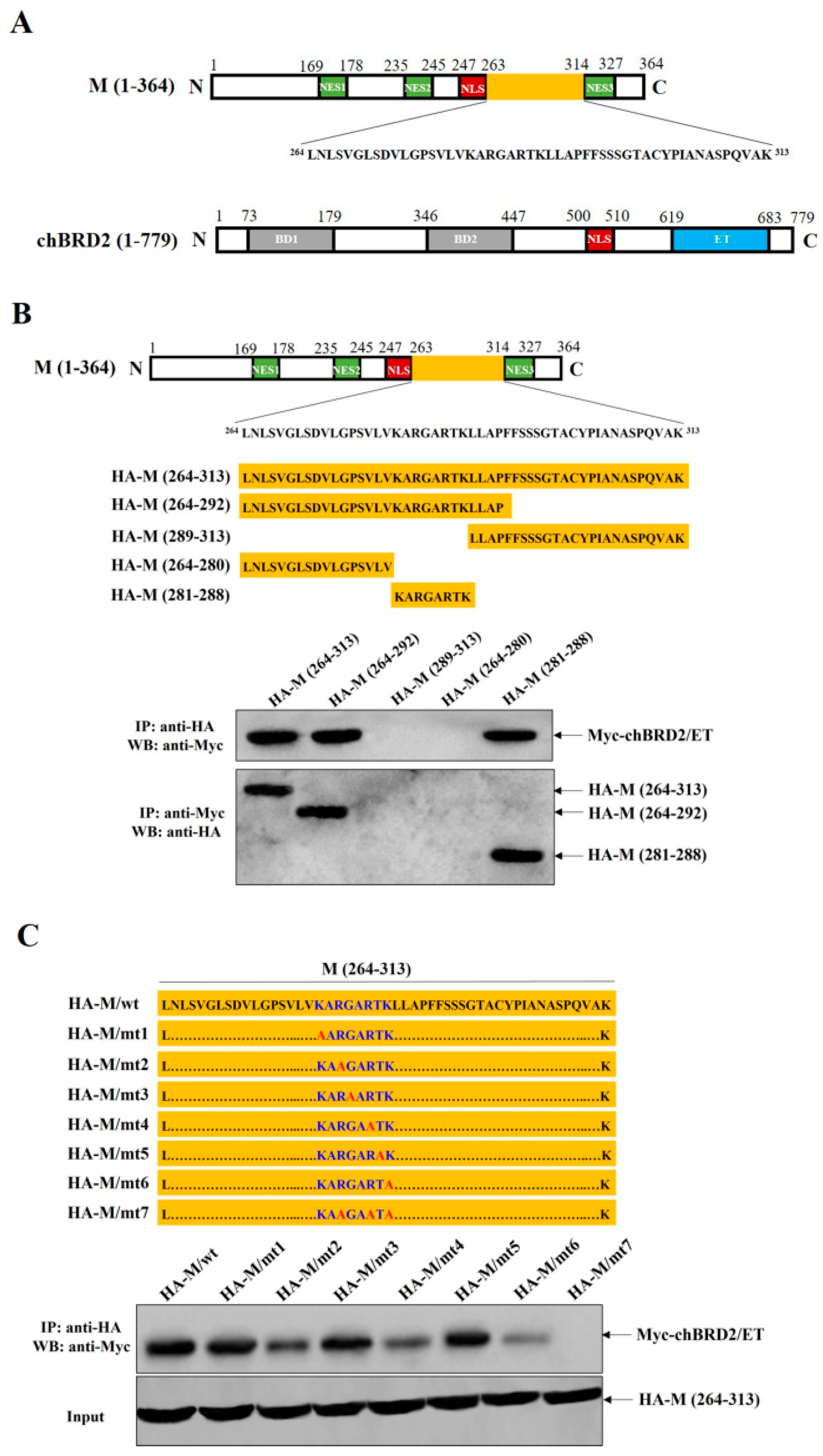

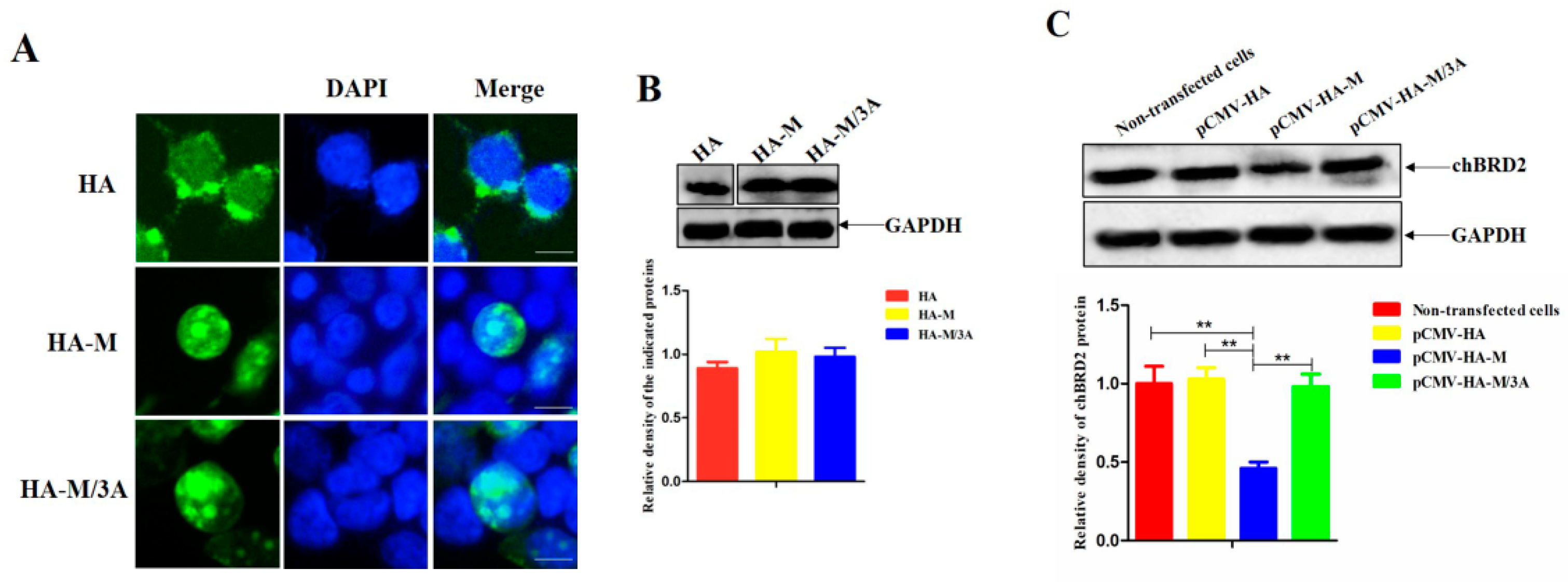

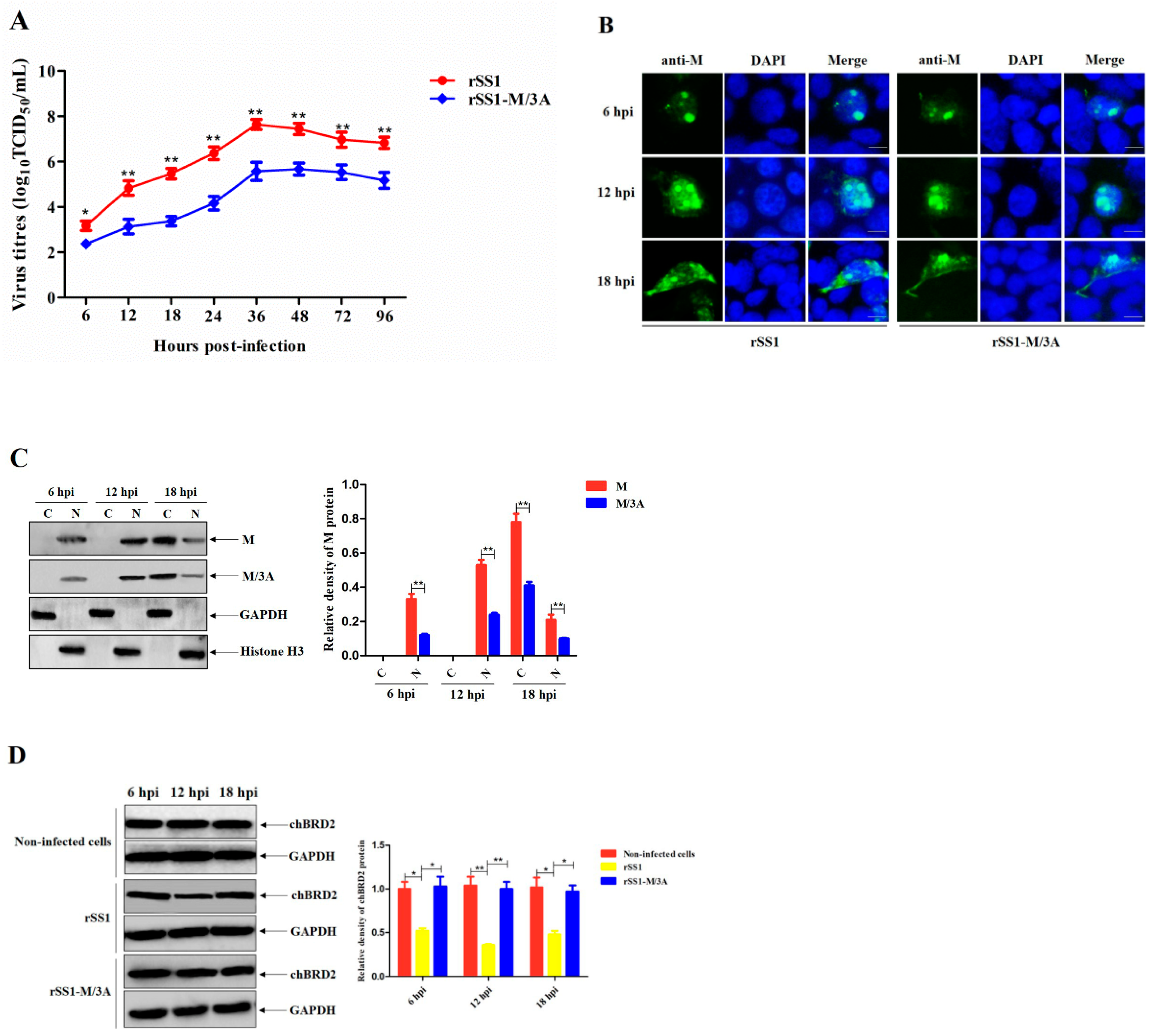
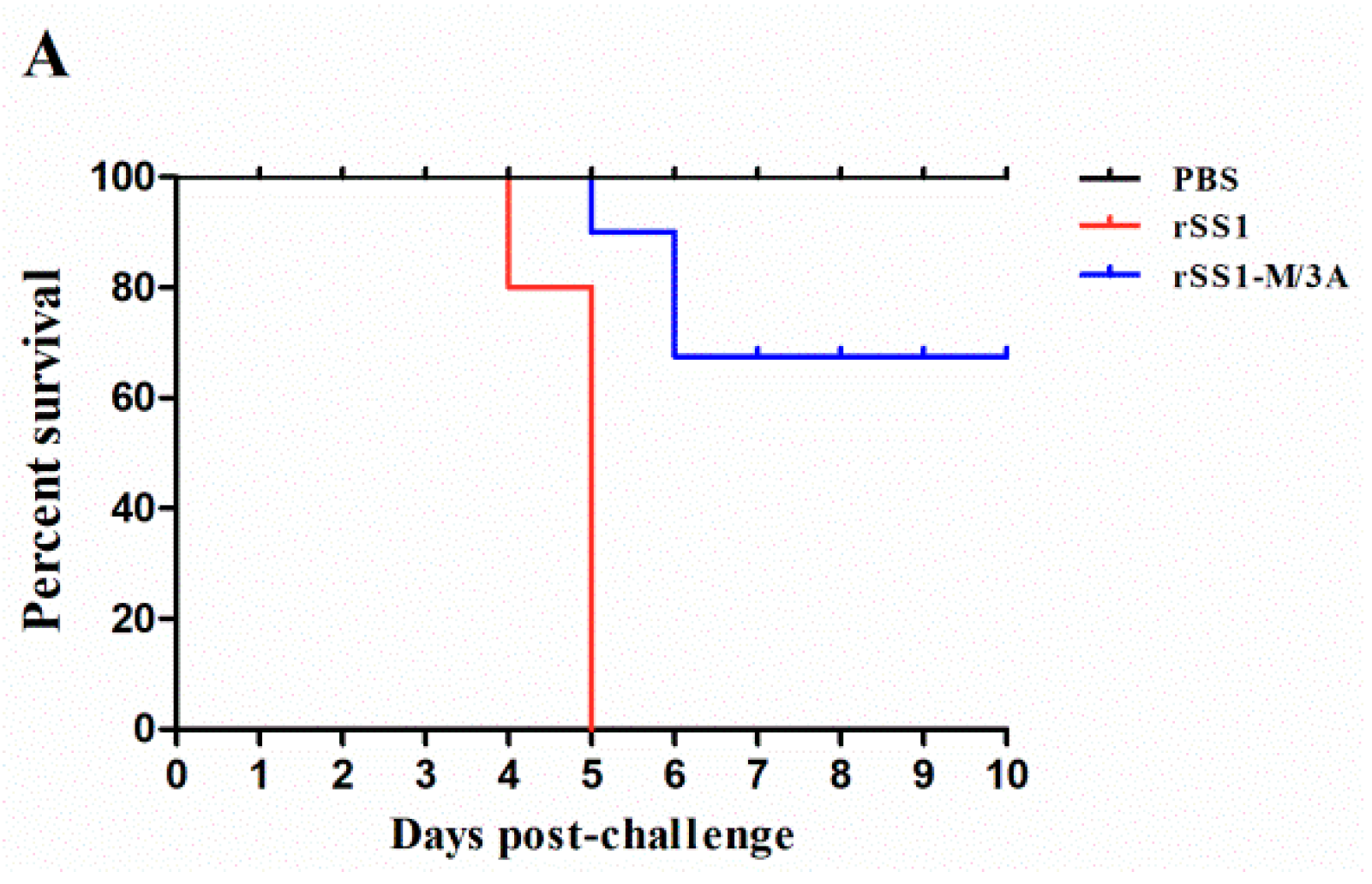
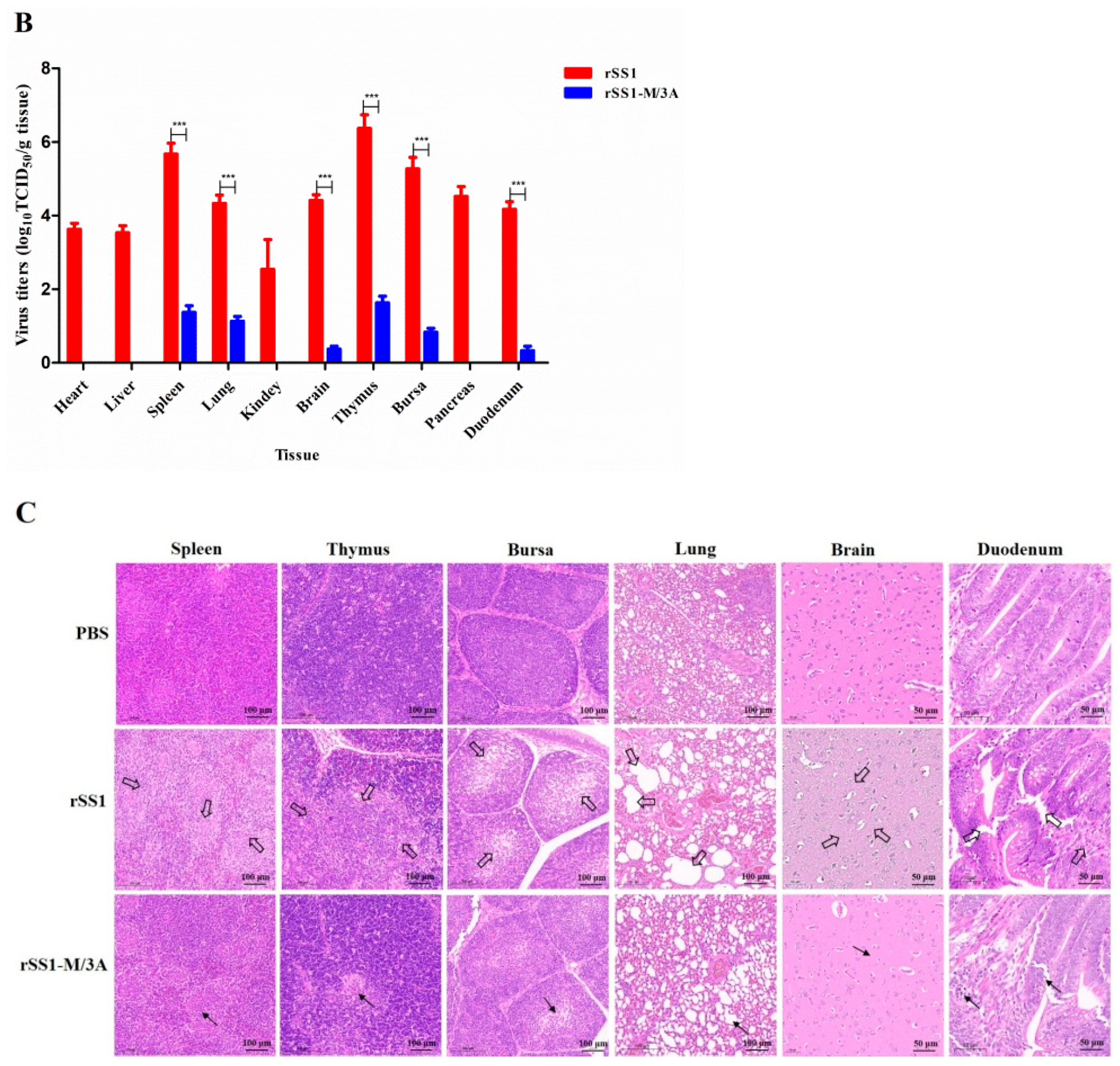
| Virus | Pathogenicity | Virus Titer | |||
|---|---|---|---|---|---|
| MDT (h) | ICPI | EID50 mL−1 | TCID50 mL−1 | HA | |
| rSS1 | 53 ± 2 | 1.90 ± 0.02 | 108.83 | 108.71 | 8 log2 |
| rSS1-M/3A | 102 ± 2 | 1.63 ± 0.01 | 106.37 | 106.58 | 5 log2 |
Disclaimer/Publisher’s Note: The statements, opinions and data contained in all publications are solely those of the individual author(s) and contributor(s) and not of MDPI and/or the editor(s). MDPI and/or the editor(s) disclaim responsibility for any injury to people or property resulting from any ideas, methods, instructions or products referred to in the content. |
© 2023 by the authors. Licensee MDPI, Basel, Switzerland. This article is an open access article distributed under the terms and conditions of the Creative Commons Attribution (CC BY) license (https://creativecommons.org/licenses/by/4.0/).
Share and Cite
Duan, Z.; Shi, H.; Xing, J.; Zhang, Q.; Liu, M. Mutation of Basic Residues R283, R286, and K288 in the Matrix Protein of Newcastle Disease Virus Attenuates Viral Replication and Pathogenicity. Int. J. Mol. Sci. 2023, 24, 980. https://doi.org/10.3390/ijms24020980
Duan Z, Shi H, Xing J, Zhang Q, Liu M. Mutation of Basic Residues R283, R286, and K288 in the Matrix Protein of Newcastle Disease Virus Attenuates Viral Replication and Pathogenicity. International Journal of Molecular Sciences. 2023; 24(2):980. https://doi.org/10.3390/ijms24020980
Chicago/Turabian StyleDuan, Zhiqiang, Haiying Shi, Jingru Xing, Qianyong Zhang, and Menglan Liu. 2023. "Mutation of Basic Residues R283, R286, and K288 in the Matrix Protein of Newcastle Disease Virus Attenuates Viral Replication and Pathogenicity" International Journal of Molecular Sciences 24, no. 2: 980. https://doi.org/10.3390/ijms24020980
APA StyleDuan, Z., Shi, H., Xing, J., Zhang, Q., & Liu, M. (2023). Mutation of Basic Residues R283, R286, and K288 in the Matrix Protein of Newcastle Disease Virus Attenuates Viral Replication and Pathogenicity. International Journal of Molecular Sciences, 24(2), 980. https://doi.org/10.3390/ijms24020980








